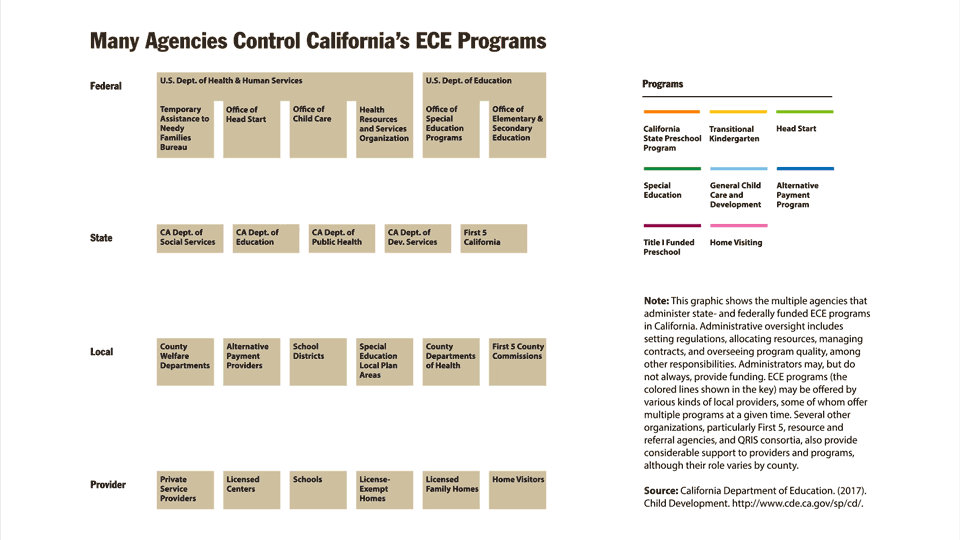Untangling California’s Early Care Programs to Improve Access and Quality

Every second, a young child’s brain forms more than 1 million new neural connections. By age 3, these growing brains will have reached 80% of their adult size. Being well cared for in warm, nurturing, and interaction-rich settings during these foundational years is essential to the healthy development of young children. Yet for many California parents and caregivers, securing stable, high-quality care to supplement their own is a daunting process.
The challenges of finding quality care are particularly difficult for the families whose incomes are too low to pay market rates for private child care providers and who instead rely on a patchwork of publicly subsidized early care and education (ECE) programs. California’s ECE programs have been developed piecemeal over the better part of a century, as new programs have come online and old ones have evolved or sunsetted. Reliance on a combination of local, state, and federal funding streams means these ECE programs are disjointed, they are governed by different administrators and use divergent standards, and there’s no one path for families to access ECE services.
On the surface, the architecture of ECE in California seems like a topic reserved for the state’s policy wonks, but its implications for children and families underscore the need for broader attention to the subject. Because of the system’s disjointed structure, children and families across the state with similar needs may experience varying levels of access, choice, and quality. For instance, the state’s subsidized early learning programs vary regarding requirements that teachers complete advanced coursework in early childhood education, the number of children that staff may supervise, and the type of curriculum used. This means, for example, that, while a child in the state preschool program is likely to experience a developmentally appropriate curriculum offered by qualified teachers with a rich set of learning materials in a small class setting, the learning experience provided to a child in a more flexible child care voucher program is subject to the luck of the draw. These divergent standards matter because research has shown that implementing early learning programs with high levels of quality is crucial to realizing their benefits for young children.
Because of the system’s disjointed structure, children and families across the state with similar needs may experience varying levels of access, choice, and quality.
The system is also complex for ECE providers to navigate. For example, early learning providers who draw on more than one funding stream may need to maintain different staff-to-child ratios throughout the day or complete multiple sets of accounting paperwork. In an industry known for narrow operating margins and limited resources, devoting significant time and resources to duplicative or burdensome administrative processes may make it more difficult for providers to offer high-quality care.
State leaders can strengthen California’s ECE system and serve more children and families with high-quality care by creating a plan of action that considers the entire ECE landscape, rather than addressing each program in a piecemeal fashion. Approaching early learning as a system of interrelated programs, from home visiting for new parents to Head Start, will help improve efficiency and enhance services for children.
One strategy for fostering such a systems perspective would be to adopt a more coordinated approach to governing California’s ECE system instead of leaving parents and providers to negotiate the hodgepodge of uncoordinated federal, state, and local programs. In other states, including Washington and North Carolina, leaders have promoted broader coordination by putting children’s services under a single administrative umbrella. Whether by creating one administrative agency, expanding the scope of existing interagency bodies, or using another administrative structure, reconceptualizing the management of the state’s ECE programs could yield great benefits for the system and the children and families it serves. California could leverage its governor-appointed advisory council to gather public input and make policy recommendations concerning ECE. Although the council does not currently have formal regulatory authority, it could focus its efforts on how to achieve a coordinated approach in the state.
The recently convened Blue Ribbon Commission on Early Childhood Education is an effort to take a systems approach to early learning. The commission is led by Assemblymember Anthony Rendon, who is deeply knowledgeable about and committed to early learning, giving advocates hope that its recommendations will enhance the care and education offered to the young children who will shape California’s future.
Tackling the tangle that undergirds California’s early learning system would be a meaningful step toward making sure every child gets a strong start. Yet addressing the system’s administrative complexity won’t singlehandedly solve the state’s early learning challenges. In addition to its complexity, the system remains underfunded, resulting in a significant gap between need and availability. In 2015–16, only one-third of eligible children under age 5 were served by one of the state’s ECE programs, leaving an estimated 650,000 children in or near poverty without access to affordable care. Access is particularly limited for infants and toddlers, with only 16% of eligible children from birth to age 3 served.
Increasing financial support for early childhood programs is critical to ensuring California’s children have access to the educational opportunities they need and deserve. This funding is also a long-term investment in the state’s economic future. Publicly funded preschool programs have been estimated to generate a return of $2–$4 per $1 invested. Intensive models, such as the High/Scope Perry Preschool program, have demonstrated even greater returns of $7–$12 per $1 invested. That’s why California’s recent state budget deal, which includes crucial steps to increase support for early learning, is to be applauded.
State leaders, including those serving on the Blue Ribbon Commission, can build on the current momentum by addressing the challenges still facing California’s ECE system and ensuring that each of the state’s children has access to high-quality learning opportunities in their formative years.

